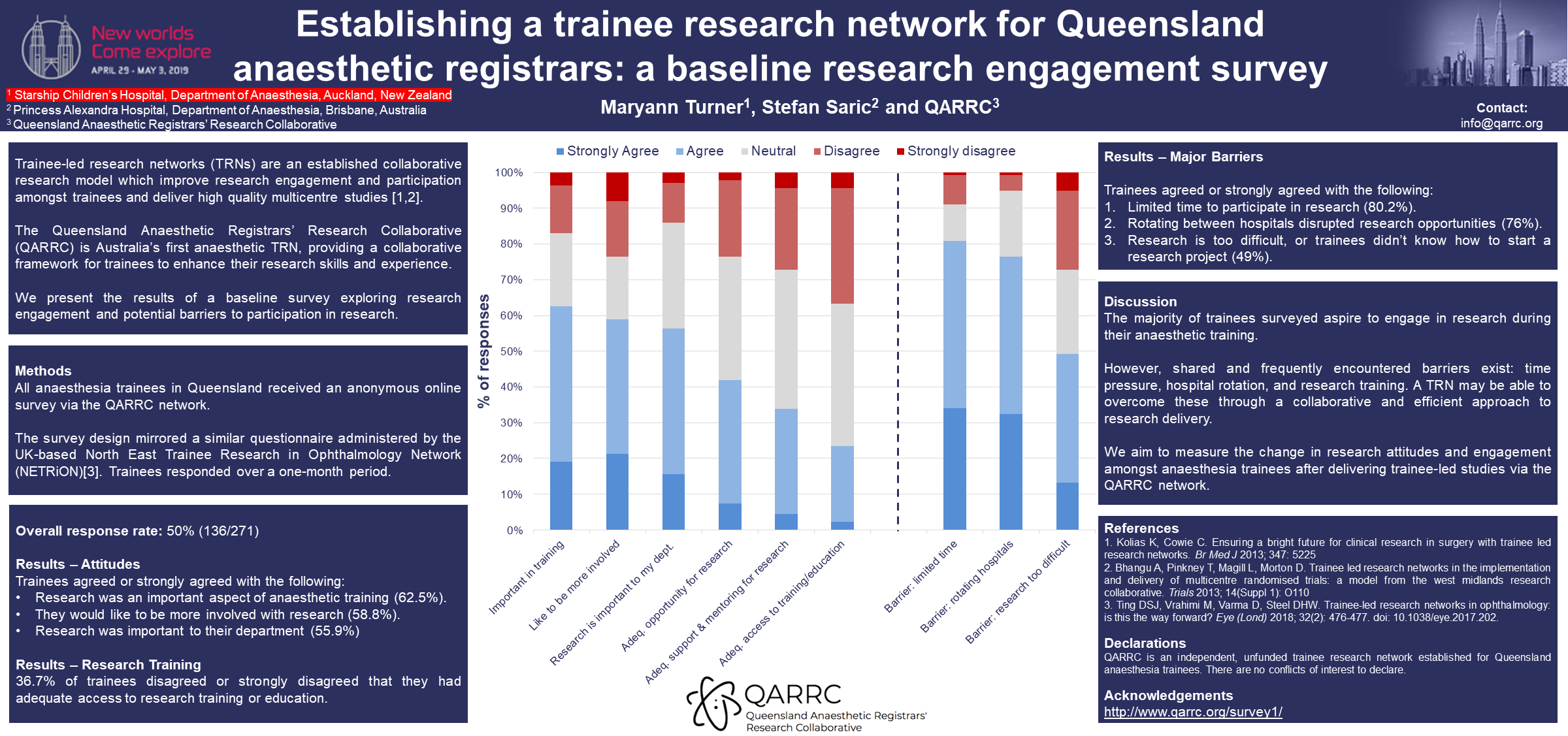QARRC’s first project, the Trainee Research Engagement Survey, was undertaken in 2019. Results were published at the ANZCA ASM (2019).

Findings
Background | Trainee-led research networks (TRNs) are an established collaborative research model, which have been demonstrated to improve research engagement and participation amongst trainees, and deliver high quality multicentre studies [1, 2]. The Queensland Anaesthetic Registrars’ Research Collaborative (QARRC) is Australia’s first anaesthetic trainee-led network, with the aim of providing a collaborative framework for anaesthesia trainees to enhance their research skills and experience. In order to gauge trainees’ research experiences to date, we have conducted a baseline survey exploring research engagement and views on potential barriers to participation in research. We hypothesised that common hurdles to research engagement exist amongst trainees (such as frequent hospital rotation or time pressure), which may be overcome by the TRN model.
Method | Following ethical approval, all anaesthesia trainees in Queensland received an anonymous 12-question online survey via the QARRC network. The survey design mirrored a similar questionnaire administered by the UK-based North East Trainee Research in Ophthalmology Network (NETRiON) [3], and trainees responded over a one-month period.
Results | We received a 51% response rate (136/271). Trainees exhibited a wide range in baseline research experience, with 30.1% of trainees being first or second author in a peer reviewed publication, while 19.9% of trainees had never engaged in any form of research. No significant correlation between level of training and research experience was found on statistical analysis (examined using Goodman-Kruskal gamma statistics, γ = 0.0021 (95% CI = -0.15, 0.16), p = 0.98).
The majority (62.5%) of trainees felt that research was an important aspect of anaesthesia training, and 58.5% felt they would like to be more involved in research. However, many barriers existed to engaging in research: e.g. a) inadequate mentoring (67.2%); b) inadequate access to education and training in research (36.7%); c) rotating between hospitals disrupted research opportunities (76%); and d) insufficient time to participate in research (80.2%).
Discussion | Although the majority of trainees surveyed aspire to engage in research during their anaesthesia training, shared and frequently encountered barriers exist: time pressure, hospital rotation, mentorship, and support. A TRN may be able to overcome these through a collaborative and efficient approach to research delivery, with mentorship from established researchers. We aim to measure the change in research attitudes and engagement amongst anaesthesia trainees after delivering trainee-led studies via the QARRC network.
References | [1] Kolias K, Cowie C. Ensuring a bright future for clinical research in surgery with trainee led research networks. Br Med J 2013; 347: 5225. [2] Bhangu A, Pinkney T, Magill L, Morton D. Trainee led research networks in the implementation and delivery of multicentre randomised trials: a model from the west midlands research collaborative. Trials 2013; 14(Suppl 1): O110. [3] Ting DSJ, Vrahimi M, Varma D, Steel DHW. Trainee-led research networks in ophthalmology: is this the way forward? Eye (Lond) 2018; 32(2): 476-477. doi: 10.1038/eye.2017.202.
Acknowledgements
Thank you to Maryann Turner, Scott Popham, David Highton, Stefan Saric, André van Zundert, Polly Spencer (Statistical Analysis), Angela Tognolini, Louis Guy, and all QARRC site leads, for your invaluable time, effort, and care for this project.
| RBWH | Andrew Souness |
| PAH | Thar Lwin |
| Mater | Ashton Jeffery |
| QCH | Anna Pietzsch |
| SCUH | Leigh White |
| Caboolture | Leigh White |
| TPCH | Rom Ranasinghe |
| Logan | Hanna Pyeon & Danielle Scott |
| Redlands | Ben Cahill |
| Toowoomba | Joyce Leung |
| Cairns | Charlotte Chew |
| Townsville | Nicole Galletly |
| MacKay | Anoop Jain |
| Ipswich | Rob Smith |
| Hervey Bay | Joshua Chew |
| GCUH | Chris Cummerford |
